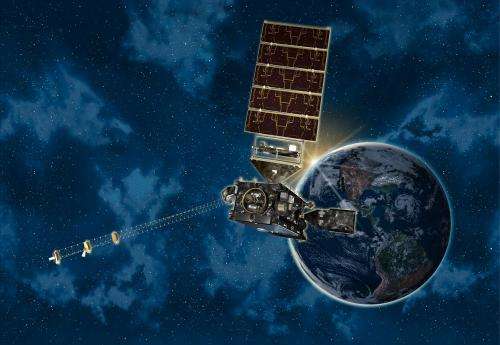GOES-R satellite program undergoes successful review

The GOES-R Series Program, which is leading the effort to replace and upgrade NOAA's existing fleet of geostationary satellites that track severe weather across the United States, received a favorable appraisal conducted by an external team of aerospace experts of its preparations to launch the new series, beginning in late 2015.
"Severe weather was again a major story in America this year," said Mary Kicza, assistant administrator of NOAA's Satellite and Information Service. "Passing this Mission Critical Design Review gives us confidence that the GOES-R Program's development is progressing well and will be ready to carry the latest technology to help improve NOAA's weather forecasts."
At all times, NOAA operates two Geostationary Operational Environmental Satellites (GOES) from a fixed position, 22,300 miles above the Earth. Additionally, NOAA keeps one GOES in orbital storage mode, ready to step in if one of the active satellites experiences trouble. NOAA's geostationary satellites constantly monitor all weather conditions, from tornadoes, floods and snowstorms, to wildfires and developing tropical storms. Instruments on GOES also monitor solar activity.
NOAA's GOES-13, which is the GOES East satellite, proved its mettle when Sandy threatened the Caribbean and the U.S., sending more than 1,200 images of the storm to NOAA forecasters, from October 20-31, as it approached—and then impacted—the Eastern seaboard.
NOAA manages the GOES-R Series Program through an integrated NOAA-NASA program office, staffed with personnel from NOAA and NASA, and co-located at NASA's Goddard Space Flight Center in Greenbelt, Md. Beginning with the first scheduled launch in 2015, the four GOES-R Series satellites will extend the GOES system through 2036.
The GOES-R satellites are expected to more than double the clarity of today's GOES imagery and provide more atmospheric observations than current capabilities with more frequent images. Data from the GOES-R instruments will be used to create many different products that will help NOAA meteorologists and other users monitor the atmosphere, land, ocean and the sun. GOES-R will also carry a new Geostationary Lightning Mapper that will provide for the first time a continuous surveillance of total lightning activity throughout the Americas and adjacent oceans.
The satellite and instruments are procured and managed by NASA as part of the GOES-R Program at NASA Goddard. "This is a critical milestone in our program," said Pam Sullivan, project manager of the GOES-R Flight Project at NASA Goddard. "We have now completed spacecraft design and are transitioning into fabrication as we prepare to integrate the GOES-R instruments."
"We're just a few years away from seeing significant improvements in the way NOAA will serve the public with better weather forecasts and warnings," said Greg Mandt, director of the GOES-R Series Program. "That's something everyone should be excited about."
More information: www.goes-r.gov/
Provided by NASA's Goddard Space Flight Center


















